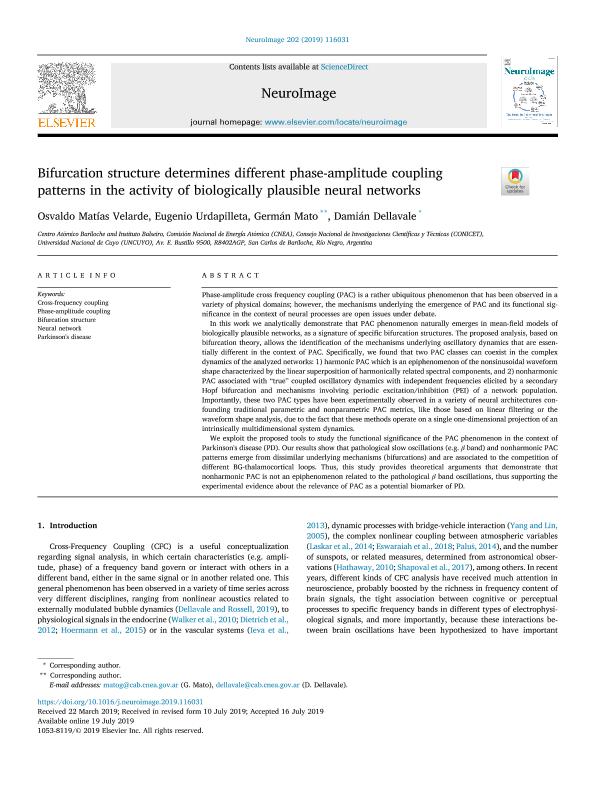Mostrar el registro sencillo del ítem
dc.contributor.author
Velarde, Osvaldo Matias

dc.contributor.author
Urdapilleta, Eugenio

dc.contributor.author
Mato, German

dc.contributor.author
Dellavale Clara, Hector Damian

dc.date.available
2021-01-22T18:26:00Z
dc.date.issued
2019-11-15
dc.identifier.citation
Velarde, Osvaldo Matias; Urdapilleta, Eugenio; Mato, German; Dellavale Clara, Hector Damian; Bifurcation structure determines different phase-amplitude coupling patterns in the activity of biologically plausible neural networks; Academic Press Inc Elsevier Science; Journal Neuroimag; 202; 116031; 15-11-2019; 1-20
dc.identifier.issn
1053-8119
dc.identifier.uri
http://hdl.handle.net/11336/123495
dc.description.abstract
Phase-amplitude cross frequency coupling (PAC) is a rather ubiquitous phenomenon that has been observed in a variety of physical domains; however, the mechanisms underlying the emergence of PAC and its functional significance in the context of neural processes are open issues under debate. In this work we analytically demonstrate that PAC phenomenon naturally emerges in mean-field models of biologically plausible networks, as a signature of specific bifurcation structures. The proposed analysis, based on bifurcation theory, allows the identification of the mechanisms underlying oscillatory dynamics that are essentially different in the context of PAC. Specifically, we found that two PAC classes can coexist in the complex dynamics of the analyzed networks: 1) harmonic PAC which is an epiphenomenon of the nonsinusoidal waveform shape characterized by the linear superposition of harmonically related spectral components, and 2) nonharmonic PAC associated with “true” coupled oscillatory dynamics with independent frequencies elicited by a secondary Hopf bifurcation and mechanisms involving periodic excitation/inhibition (PEI) of a network population. Importantly, these two PAC types have been experimentally observed in a variety of neural architectures confounding traditional parametric and nonparametric PAC metrics, like those based on linear filtering or the waveform shape analysis, due to the fact that these methods operate on a single one-dimensional projection of an intrinsically multidimensional system dynamics. We exploit the proposed tools to study the functional significance of the PAC phenomenon in the context of Parkinson's disease (PD). Our results show that pathological slow oscillations (e.g. β band) and nonharmonic PAC patterns emerge from dissimilar underlying mechanisms (bifurcations) and are associated to the competition of different BG-thalamocortical loops. Thus, this study provides theoretical arguments that demonstrate that nonharmonic PAC is not an epiphenomenon related to the pathological β band oscillations, thus supporting the experimental evidence about the relevance of PAC as a potential biomarker of PD.
dc.format
application/pdf
dc.language.iso
eng
dc.publisher
Academic Press Inc Elsevier Science

dc.rights
info:eu-repo/semantics/openAccess
dc.rights.uri
https://creativecommons.org/licenses/by-nc-nd/2.5/ar/
dc.subject
BIFURCATION STRUCTURE
dc.subject
CROSS-FREQUENCY COUPLING
dc.subject
NEURAL NETWORK
dc.subject
PARKINSON'S DISEASE
dc.subject
PHASE-AMPLITUDE COUPLING
dc.subject.classification
Otras Ciencias Físicas

dc.subject.classification
Ciencias Físicas

dc.subject.classification
CIENCIAS NATURALES Y EXACTAS

dc.title
Bifurcation structure determines different phase-amplitude coupling patterns in the activity of biologically plausible neural networks
dc.type
info:eu-repo/semantics/article
dc.type
info:ar-repo/semantics/artículo
dc.type
info:eu-repo/semantics/publishedVersion
dc.date.updated
2020-12-16T18:26:01Z
dc.journal.volume
202
dc.journal.number
116031
dc.journal.pagination
1-20
dc.journal.pais
Países Bajos

dc.description.fil
Fil: Velarde, Osvaldo Matias. Comisión Nacional de Energía Atómica. Gerencia del Área de Energía Nuclear. Instituto Balseiro; Argentina. Universidad Nacional de Cuyo; Argentina. Consejo Nacional de Investigaciones Científicas y Técnicas. Centro Científico Tecnológico Conicet - Patagonia Norte; Argentina
dc.description.fil
Fil: Urdapilleta, Eugenio. Comisión Nacional de Energía Atómica. Gerencia del Área de Energía Nuclear. Instituto Balseiro; Argentina. Universidad Nacional de Cuyo; Argentina. Consejo Nacional de Investigaciones Científicas y Técnicas. Centro Científico Tecnológico Conicet - Patagonia Norte; Argentina
dc.description.fil
Fil: Mato, German. Comisión Nacional de Energía Atómica. Gerencia del Área de Energía Nuclear. Instituto Balseiro; Argentina. Universidad Nacional de Cuyo; Argentina. Consejo Nacional de Investigaciones Científicas y Técnicas. Centro Científico Tecnológico Conicet - Patagonia Norte; Argentina
dc.description.fil
Fil: Dellavale Clara, Hector Damian. Comisión Nacional de Energía Atómica. Gerencia del Área de Energía Nuclear. Instituto Balseiro; Argentina. Universidad Nacional de Cuyo; Argentina. Consejo Nacional de Investigaciones Científicas y Técnicas. Centro Científico Tecnológico Conicet - Patagonia Norte; Argentina
dc.journal.title
Journal Neuroimag

dc.relation.alternativeid
info:eu-repo/semantics/altIdentifier/url/https://reader.elsevier.com/reader/sd/pii/S1053811919306123?token=84A7B68FD18EE64C83E1D40E69265629ED0A56152E92FC9075970659A986D633B7552B4A4D74332782EFA0E494F11C3C
dc.relation.alternativeid
info:eu-repo/semantics/altIdentifier/doi/https://doi.org/10.1016/j.neuroimage.2019.116031
Archivos asociados
